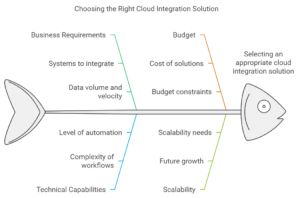
Whether you’re a small business just starting your digital transformation journey or a large enterprise looking to optimize your existing systems, cloud integration offers the tools and capabilities to drive efficiency, foster innovation, and achieve business success.
Businesses are increasingly leveraging technology to streamline operations, improve efficiency, and drive growth. One such technology that has become a game-changer is cloud integration.
Cloud integration is the process of configuring multiple application programs to share data in the cloud. In a typical cloud integration setup, various applications, systems, and IT environments communicate seamlessly with one another, either in real-time or at scheduled intervals.
The importance of cloud integration cannot be overstated. With the proliferation of cloud-based applications and tools, businesses are finding it necessary to ensure that these disparate systems can communicate effectively. This is where cloud integration comes into play. It eliminates data silos, enhances information flow, and ensures that all parts of the organization have consistent, up-to-date data.
Benefits of integrating cloud-based systems and applications
Integrating cloud-based systems and applications brings a host of benefits. Here are some key ones:
- Improved Efficiency: Cloud integration automates data exchange between systems, reducing manual data entry and the chances of errors. This leads to significant time savings and increased operational efficiency.
- Better Decision Making: With integrated systems, businesses have access to accurate, real-time data across all platforms. This leads to more informed decision making.
- Increased Agility: Integrated cloud systems allow businesses to be more agile. They can easily scale up or down based on demand, launch new services quickly, and respond faster to market changes.
- Cost Savings: By eliminating the need for maintaining on-premise hardware and software, cloud integration can lead to substantial cost savings.
Cloud Data Integration: Bridging the Gap
-
Exploring the challenges of data integration in the cloud
It’s essential to acknowledge the roadblocks that might come our way. Data integration in the cloud, while offering numerous benefits, also presents its own set of challenges.
One of the primary hurdles is data security. As data moves between different systems across the cloud, ensuring its security becomes paramount. Another significant challenge is dealing with data inconsistency due to the presence of multiple sources. This can lead to discrepancies and inaccuracies, affecting decision-making processes.
Additionally, integrating data from legacy systems can be a complex task due to compatibility issues. Also, managing the sheer volume of data generated by businesses today can be overwhelming.
-
Techniques and best practices for seamless cloud data integration
Despite these challenges, the power of cloud data integration cannot be understated. With the right techniques and practices, you can overcome these hurdles and unlock the full potential of your data.
Implement Robust Security Measures: Ensure the use of encryption, secure data transfer protocols, and access controls to protect your data at all times.
Use Consistent Data Formats: To avoid issues with data inconsistency, use consistent data formats and standards across all your systems.
Leverage ETL Tools: Extract, Transform, Load (ETL) tools can help manage large volumes of data and streamline the process of integrating data from various sources.
Plan for Scalability: Always plan for future growth. Your cloud data integration strategy should be able to handle increasing data volumes as your business grows.
Remember, the goal is to create a cohesive ecosystem where data flows seamlessly, providing valuable insights to drive your business forward.
Salesforce Sales Cloud IVR API Integration: Enhancing Customer Engagement
-
Overview of Salesforce Sales Cloud and IVR systems
Salesforce Sales Cloud is a leading customer relationship management (CRM) platform that helps businesses manage their sales, customer service, and marketing efforts more effectively. On the other hand, Interactive Voice Response (IVR) systems are telephony menu systems that use voice recognition to automate the identification, segmentation, and routing of callers to the most appropriate agent within your team.
-
Benefits of integrating IVR systems with Salesforce Sales Cloud
When you integrate your IVR system with Salesforce Sales Cloud, you create a powerhouse of customer engagement. Here’s why:
- Improved Customer Service: When a customer calls, their information from Salesforce can be automatically pulled up, giving the support agent a complete view of the customer’s history and enabling personalized service.
- Increased Efficiency: With automatic call logging in Salesforce, agents save time and reduce errors, leading to more efficient service and happier customers.
- Enhanced Reporting: Detailed call logs in Salesforce allow for better tracking and reporting, leading to valuable insights about customer behavior and agent performance.
-
API integration methods and considerations for a successful integration
API (Application Programming Interface) integration serves as a bridge between Salesforce Sales Cloud and IVR systems, allowing them to communicate and share data. However, successful integration requires careful planning and execution. Key considerations should include evaluating the reliability of the API, understanding its documentation, and testing before full-scale implementation.

Cloud Integration Services: Driving Business Efficiency
-
Overview of cloud integration services and their role in enterprise transformation
Cloud integration services are third-party solutions that help businesses connect their various cloud and on-premise applications. These services play a pivotal role in digital transformation by breaking down data silos, improving process automation, and enabling real-time data access across systems.
-
Key service offerings and advantages of leveraging cloud integration service providers
Cloud integration services offer a range of solutions, including data integration, API management, process integration, and more. By leveraging these services, businesses can enjoy faster integration processes, expert technical support, and access to the latest integration technologies.
Moreover, these service providers often bring industry-specific knowledge and experience, helping businesses navigate their unique integration challenges.
Cloud Integration Solutions: Choosing the Right Fit
-
Exploring different cloud integration solution options
The world of cloud integration is vast and diverse, offering a plethora of solutions designed to meet varying business needs. From simple data synchronization tools to complex enterprise service bus (ESB) solutions, the range is wide.
iPaaS (Integration Platform as a Service) solutions, for example, provide a cloud-based platform that connects various applications, data sources, and APIs in the cloud and on-premise.
Data Integration Tools, on the other hand, focus more on the extraction, transformation, and loading of data from different sources.
-
Assessing business requirements and selecting appropriate integration solutions
Choosing the right cloud integration solution isn’t a one-size-fits-all scenario. It requires a careful assessment of your business needs, technical capabilities, budget, and long-term goals.

Begin by identifying the systems and applications that need to be integrated. Consider factors like the volume and velocity of data that will be handled, the complexity of your workflows, and the level of automation required. Also, consider future growth and scalability needs.

Cloud Integration Platforms: Enabling Seamless Connectivity
-
Overview of cloud integration platforms and their capabilities
Cloud integration platforms are the backbone of any successful cloud integration strategy. These platforms provide the infrastructure and tools needed to connect various cloud and on-premise systems, enabling seamless data flow and process automation across your organization.
Capabilities of these platforms can include data integration, API management, B2B integration, real-time monitoring, and more. They often come with pre-built connectors for popular systems and applications, making the integration process quicker and easier.
-
Key features and considerations for choosing the right cloud integration platform
Your choice of a cloud integration platform should align with your business needs and technical capabilities. Here are some key features to look out for:
- Ease of Use: A user-friendly interface with an intuitive design can make the integration process smoother, even for non-technical users.
- Pre-built Connectors: These can significantly speed up the integration process by eliminating the need for custom coding.
- Scalability: The platform should be able to handle increasing data volumes and complexity as your business grows.
- Robust Security: Look for platforms with strong security measures, including encryption, access controls, and audit logs.
- Support and Documentation: Comprehensive support and well-documented resources can be a lifesaver when you run into issues or need help understanding certain features.
Cloud Platform Integration: Unifying Systems and Workflows
-
Exploring the benefits of integrating cloud platforms
Integrating different cloud platforms can propel your business to new heights of operational efficiency and agility. Here’s how:
Streamlined Workflow: By automating data exchange between systems, you eliminate manual data entry and streamline your workflows.
Real-Time Data Access: Integrated platforms provide real-time access to data, enabling timely and informed decision-making.
Improved Collaboration: When your teams can access and share data seamlessly across platforms, collaboration becomes easier and more effective.
-
Use cases and examples of cloud platform integration
Let’s explore a few practical use cases of cloud platform integration:
- Marketing Automation and CRM Integration: Integrating a marketing automation platform like HubSpot with a CRM like Salesforce can align your sales and marketing efforts, providing a unified view of the customer journey.
- E-commerce and Accounting Software Integration: When platforms like Shopify are integrated with accounting software like QuickBooks, sales data can be automatically synced, making financial management easier and more accurate.
- HR System and Payroll Software Integration: This can automate the transfer of employee data from the HR system to the payroll software, ensuring timely and accurate payroll processing.
Integration Solutions: Building a Connected Ecosystem
-
Understanding the importance of integration in today’s digital landscape
In our hyper-connected digital world, integration has become a critical aspect of business strategy. Whether it’s connecting different cloud platforms, integrating on-premise systems with the cloud, or linking disparate applications within a single platform, integration helps build a connected ecosystem where data flows seamlessly, driving operational efficiency, improving customer experiences, and enabling innovation.
-
Exploring different integration solutions and their applications
From simple point-to-point connectors to complex network-based integrations, there’s a wide range of integration solutions available today. The choice depends on your specific needs.
API-Based Integration allows different systems to communicate and share data via APIs. This is particularly useful for real-time integrations and for connecting modern, cloud-based applications.
Data Integration solutions focus on integrating data from different sources, transforming it as needed, and loading it into a destination system. This is crucial for any business that relies on data-driven insights.
Process Integration solutions, on the other hand, concentrate on automating and optimizing business processes by integrating the systems involved in these processes.
Integration Defined: The Essentials
-
Defining Integration and its role in business processes
At its core, integration is about connecting different systems, applications, or platforms so they can communicate and share data with each other. But it’s not just about the technical aspects of establishing connections; it’s also about ensuring that these connections add value to your business.
Integration plays a crucial role in streamlining business processes, eliminating data silos, and enhancing collaboration. By enabling real-time data access across systems, integration empowers businesses to make informed decisions quickly, respond to changes swiftly, and deliver superior customer experiences.
-
Overview of integration techniques and Methodologies
There are several techniques and methodologies used in integration, each with its own strengths and use cases.
Point-to-Point Integration is the simplest form, where two systems are directly connected. It’s quick and easy but can become complex and hard to manage as more systems are added.
Middleware Integration uses a third-party solution (the middleware) as a go-between to facilitate communication between systems. This can simplify management and offer additional features like data transformation and error handling.
Service-Oriented Architecture (SOA) is a method where services are exposed through APIs, allowing other systems to use these services without knowing their underlying implementation.
Enterprise Service Bus (ESB) is a more robust solution designed for complex integrations. It provides a central hub where all systems connect, making it easier to manage and scale.

Conclusion: Embracing Cloud Integration for Business Success
As we wrap up this comprehensive guide on cloud integration, it’s clear that integration is no longer an optional luxury but a critical necessity for businesses aiming to thrive in the digital age.
Whether you’re a small business just starting your digital transformation journey or a large enterprise looking to optimize your existing systems, cloud integration offers the tools and capabilities to drive efficiency, foster innovation, and achieve business success.
From understanding the basics of cloud integration to exploring different solutions, platforms, and techniques, we’ve covered a lot of ground. But remember, the world of cloud integration is vast and constantly evolving. As new technologies emerge and business needs change, staying informed and adaptable is key.
So, here’s to unleashing the power of cloud integration and propelling your business to new heights of success!
Ready to innovate and transform your business? Say hello to CodeBeavers!
If you are looking for ways to bring your product or app ideas to life? We’ve got your back. CodeBeavers has the tools and engineers you need to make your projects come alive. With CodeBeavers, you’ll be able to build faster than ever, deploy code with ease, and scale like never before. Send us your requirements now, and let’s start winning together.




